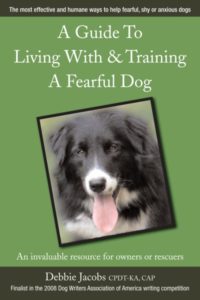
Play time with other dogs can be a perk at a boarding facility.
Living with a dog with fear based behavior challenges impacts our lives in many ways and the freedom to be away from home for more than 8 hours can be among them.
A couple of the options available for our dogs’ care when we need to be away are; someone comes to our home and cares for them or they go somewhere for boarding. Your dog and the options available to you in your area, will determine which, if either, you choose to use. There are a variety of factors to take into consideration, and obviously your dog’s physical and emotional well-being top the list. It’s impossible for me to list all the considerations an individual pet owner needs to look at. Some guidelines to follow include:
1. Speak with a vet about medications or supplements that can lower a dog’s overall level of anxiety.
2. Create an environment in which the dog feels safe and can retreat to if they need to.
3. Desensitize and counter condition a dog to basic handling.
4. Find and educate the person, or persons who will be providing care for your dog.
In-home care is often best for many dogs, especially those with a range of fears. The challenge of finding appropriate care-givers and the expense will impact whether or not you choose this option. It’s helpful if you can set up an environment which facilitates easy management of your dog. Having a door which leads to a fenced in yard works well if your dog is able to respond to cues for going out and coming back in. A care-giver need only be a door opener and food deliverer. But if a dog is too scared to move for someone we have to come up with alternatives.
It may be necessary to create areas where a dog can urinate and defecate without going outside. It is not a given that a dog who does this will forget their housetraining skills. My own two fearful dogs were provided with papers or pads and used them early in their lives with us. Once they were given access to the outdoors they chose that area, and not inside the house, for toileting.
Giving a dog a few basic skills, and teaching a caregiver how to interact with your dog can allow them to get your dogs outside for toileting and exercise. Having a leash put on their collar or harness is one skill. Being able to walk with a long line attached to their collar or harness is another. Adding a short tag line (approx 12″) to a harness or collar with a loop or ring in the end can make it easier for a caregiver to leash up a dog without having to put as much pressure on a dog as grabbing a collar or harness will. I was able to instruct care-givers on how to put a leash on my dog, get him to follow them out of the house, and go for walks. I was very clear that my people-fearful dog did not need or want any social interactions in addition to feeding, leash walks and toileting. I made sure there was an ample supply of my dog’s favorite treats and care-givers were instructed on how to give them to him; no eye contact, no petting, no bending over the dog, no chatter.
There are professional pet and house sitters available. Be on the look out for anyone who assumes that all dogs will like and feel comfortable with them. These folks, good intentions aside, often try too hard to connect with a dog, a dog who may have no interest in connecting with them. They will need to be able to put their egos and anything they’ve learned in the past about dogs, aside. Some will be willing and able to do this, others will not. I had good success with a young woman who worked with cats at the local humane society. She was comfortable with dogs and able to understand that a fearful dog is not unlike a scared cat. Try as you like, you are not going to make a scared cat like you. Our neighbors were also a great help to us, and continue to be. Vet techs are another good population of possible candidates for pet care.
For some dogs being boarded away from home can be both a physically and emotionally safe, option for them. The understanding of fear based behaviors by the people handling your dog is crucial. A dog who is comfortable with other dogs may enjoy the opportunity to be with them during play time. A boarding kennel may be a safer place for a dog if you do not have a secure, fenced area at home. If you have more than one dog there is often the choice to have them share a kennel, providing them with the comfort and solace of a buddy. Look for kennels set up so that your dog does not require handling for cage cleaning or feeding. A safe space can be created, a crate to hide in or a barrier to hide behind for example, while cleaning occurs.
Staff who understand fearful dogs or are willing to follow instructions regarding how your dog should be handled and interacted with, is imperative. Large kennels may employ a collection of low skilled workers who may like dogs, but may have misguided ideas about them. People professionally involved with dogs can assume they know more about your dog than you do. I was surprised to hear one kennel owner tell me that she thought people gave too many drugs to dogs. When a dog I knew stayed at her kennel and was sent along with behavioral medications, she did not give them to the dog, despite the owner’s instructions. The kennel operator decided that the dog was fine without them. I was dumbstruck. There are medications which require a specific withdrawal protocol before they cease to be used. To abruptly stop their use can be dangerous. As for the dog appearing to fine, the medications may have been reason!
In-home boarding is popular and many pet owners assume a better option than a commercial facility. Whether this is the case will be depend on the people providing the care, your dog’s triggers, and the adequacy of fencing on the property. I offer in-home boarding and have turned away dogs and suggested a boarding kennel instead. Home life, especially a home with other unrestrained dogs, is unpredictable. A fearful dog may fare better with the predictable routines of a kennel, along with the isolation option it provides. I will not board a fearful dog who does not have a recall. Unlike a commercial kennel the opportunity to slip out an open door or find a way out of the fence yard exists. Most dogs don’t choose to leave me or my other dogs, but a fearful dog, once outside of the confines of my home or yard may be impossible to catch.
Every dog and every situation is going to be different. By giving a dog a foundation of basic skills, experimenting with medications to help relieve a dog’s anxiety, and researching both in and away from home options, it is possible to have a life away from your fearful dog.





